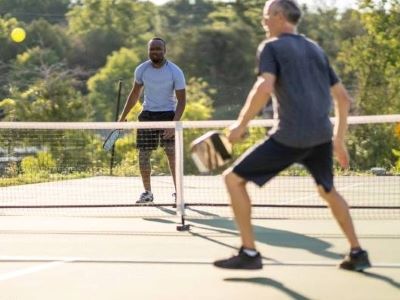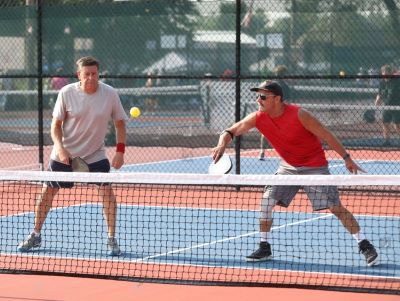Are you a pickleball enthusiast looking for new places to play? Have you ever wondered that can you play pickleball on a tile floor? While some players swear by the smooth surface, others may hesitate to try it.

In this blog post, we’ll explore the pros and cons of playing pickleball on a tile floor and some essential do’s and don’ts to remember. So before you head out onto the court, read on to find out everything you need to know about playing pickleball on the tile!
Can You Play Pickleball on a Tile Floor?
The answer is yes, but there are some things to consider before playing pickleball on a tile floor. Tile floors can provide an excellent playing surface for pickleball due to their low friction and durability.
However, there are some precautions that players should take when playing pickleball on a tile floor to ensure safety and maximize the game’s enjoyment. Players should make sure they wear shoes with good grip to prevent slipping while playing, as well as using pickleballs explicitly designed for hard court surfaces.

Additionally, players should remember that a tile floor may bounce the ball higher and faster than on other surfaces. To keep up with the game’s pace, they must have quick reflexes.
When done correctly, playing pickleball on a tile floor can be an enjoyable experience for all involved!
Pros and Cons of Playing Pickleball on a Tile Floor
Recent years have seen a rise in the popularity of tile flooring for pickleball games. Like any other flooring material, playing pickleball on a tile floor has pros and cons.
Pros
- Durability and Stability: The durability and stability of tile flooring are well-known. It can endure the weight of numerous footsteps and the impact of the ball and paddle without displaying any signs of damage. Additionally, the firm base of tile flooring aids in reducing the risk of tripping, slipping, or falling during gameplay.

- Low Maintenance Requirements: Tile flooring requires minimal maintenance. Cleaning and disinfecting it with a mild detergent solution and a mop is easy. Unlike other flooring materials, tile does not require regular waxing or refinishing, which can save time and money in the long run.
- Improved Traction for Players: Tile floors offer a better hold on smooth surfaces, like hardwood or laminate, due to their texture which creates a surface that is not slippery. It enables players to move around easily and quickly, decreasing the possibility of slipping or sliding. It can enhance the overall playing experience while reducing the risk of injuries.
Cons
- Slippery Surface When Wet: One of the main disadvantages of playing pickleball on a tile floor is that it can become slippery when wet. It is important to keep the surface clean and dry. If moisture is present, there is a greater risk of slipping and falling. It is a concern for older adults or players with mobility issues.
- Risk of Injury From Slipping: Injuries from slipping on tile flooring can range from mild bruises and sprains to more severe fractures and head injuries. The player should exercise extra caution when playing on a tile floor, especially if the surface is wet.
- Increased Noise Level While Playing: Another disadvantage of playing pickleball on a tile floor is that it can create a loud noise during gameplay. The ball bouncing off the paddle and the base can echo throughout the room, which can be disruptive for players and spectators alike.
Do’s & Don’ts of Playing Pickleball on a Tile Floor
Pickleball is a fun and exciting sport played on various surfaces, including tile flooring. However, there are sure do’s and don’ts to remember when playing pickleball on a tile floor to ensure a safe and enjoyable experience for everyone involved. Here are some essential tips to follow:

Do’s
- Wear Appropriate Footwear: Proper athletic shoes with good traction are essential when playing pickleball on a tile floor. Avoid shoes with smooth soles or high heels that can increase the risk of slipping.
- Do Keep the Surface Dry: Wet tile flooring can be slippery and dangerous to play on. Make sure to dry the surface thoroughly before playing, especially after cleaning.
- Do Use a Non-slip Grip on Your Paddle: Using a non-slip grip on your paddle can improve your grip and prevent the paddle from slipping out of your hand.
- Communicate With Your Partner: Good communication is vital to avoiding collisions and injuries on the court. Make sure to establish a system of signals or calls to avoid confusion.
- Respect the Noise Level: Tile flooring can create a loud noise level during gameplay. Be mindful of others nearby and avoid shouting or excessive noise.
Don’ts
- Don’t Wear Street Shoes: Street shoes can damage the surface of the tile flooring and increase the risk of slipping. Only wear proper athletic shoes on the court.

- Don’t Allow Water or Other Liquids on the Court: Liquids can make the tile flooring slippery and hazardous to play on. Make sure to clean up spills immediately and avoid bringing beverages onto the court.
- Don’t Lean on the Net: Leaning on the net can damage the structure and cause it to become unstable. Use the net as intended and avoid putting any unnecessary weight on it.
- Don’t Bring Food or Chewing Gum Onto the Court: Food and gum can create a mess and make the tile flooring slippery. Avoid getting any food or gum onto the court.
- Remember to Warm Up and Stretch: Like any sport, it’s essential to warm up and stretch before playing pickleball on a tile floor. It can help prevent injuries and improve your gameplay.
FAQs
Yes, pickleball can be played on a wooden floor. However, using an indoor court surface or specifically designed pickleball court tiles is essential to provide the best playing experience. Wooden floors can be slippery and require specific care and maintenance for the best playing conditions.
A hard, flat surface is best for playing pickleball. Commonly used surfaces include wood, concrete, tile, and sport court flooring. Outdoor pickleball courts are often made of asphalt or concrete with permanent lines for the court boundaries.
Indoor pickleball is played on a badminton-sized court, typically with walls on the sides. The court is divided into two equal sections by an 8-foot high net across the center. Players use paddles and a perforated plastic ball to hit over or around the net back and forth between each other to score points. Pickleball rules for indoor courts are similar to outdoor ones, except that shots cannot go out-of-bounds and must remain within the court’s four walls.
Conclusion
In conclusion, playing pickleball on a tile floor is possible, but it may be more complex than playing on other surfaces. The smooth surface of the tiles can make some shots more difficult to control and could cause players to slip or fall. Using caution when playing pickleball on a tile floor is essential to avoid any potential injuries.
We hope this article helped answer your questions about playing pickleball on a tile floor so you can confidently decide where to play next time!

I am a professional physiotherapist and the author of the BallSportsPro. I worked with athletes of all levels, from amateur to professional, and i helped them overcome injuries and improve their performance. I am a certified Pickleball instructor and has been playing the sport for over 10 years.




